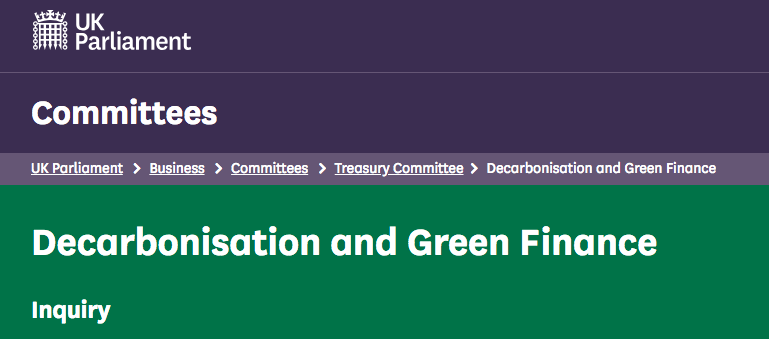We are writing with respect to the committee’s Decarbonisation and Green Finance inquiry, and specifically to the question of the economic costs and benefits that decarbonisation presents for the UK.
Introduction
A target to decarbonise the economy (“net zero”) was agreed by Parliament in 2019. Ahead of the debate, the minister, Chris Skidmore, informed MPs that the cost of achieving the target would be modest – 1–2% of GDP in 2050 – a figure apparently provided by the Committee on Climate Change (CCC). This claim was reinforced by subsequent statements in the House of Lords by Lord Deben, the chairman of the CCC,(1) and in public pronouncements by Chris Stark, its chief executive.(2)
Claims of modest costs were false
The Treasury and BEIS have disputed the CCC’s figure, although not necessarily on the grounds that it was understated. However, it is now appears that the CCC’s figure was not based on explicit calculations; they have said that they have not calculated a cost for any of the years 2020-2049.(3) The Treasury and BEIS have both refused to release details of their own estimates of the cost.
Thus no official costings of the net zero project have been published, and it appears likely that Parliament was misled into voting for the measure.
In reality the costs are going to be very high
The central plank of the decarbonisation plan is the replacement of fossil fuels with electricity, mostly supplied by offshore windfarms. In other words, it involves the wholesale electrification of most of the economy, although in some sectors, where this is not possible, it is said that hydrogen will be used to deliver energy.
A necessary (but not sufficient) condition for decarbonisation at “modest” cost is that the electricity from offshore windfarms be very cheap. It has been argued in the media and by windfarm promoters that the costs of offshore wind are falling rapidly. They point to the results of the 2017 Contracts for Difference auction, in which two offshore windfarms – Moray East and Hornsea 2 – won contracts at just £57.50/MWh, less than half the price of any previous winner, and much closer to market prices.
However, a recent review of published accounts of operational UK offshore windfarms showed that costs are barely falling, and remain above £100/MWh.(4) While it has been argued that the review was backward looking, and thus not representative of the windfarms that are coming on stream in the next few years, examination of the accounts of those new windfarms shows that no major reductions in capital expenditure are likely to be forthcoming. For example, the foundations for the Moray East windfarm were completed in February 2020. By that point, the developers had spent over £1.2 billion, thus suggesting that the final bill will run to nearly £4 billion once the turbines and ancillary works have been installed.(5)
But the capital spend needs to be kept to well below £2 billion if the windfarm is to be profitable at £57.50/MWh. The costs look as though they will be in line with previous windfarms, and thus, unequivocally, electricity from offshore windfarms will remain very expensive for the foreseeable future. These high costs will have to be passed on to consumers.
It is important that members of the committee understand that the cost of electricity coming from the wind turbines is only part of the equation. To decarbonise at modest cost, it is also necessary to have a very cheap way to deal with the intermittency caused by fluctuations in the wind.
At present there is no technology that can be applied to do this at the scales required in the UK at anything other than astronomical cost. This is true of batteries, pumped hydro and hydrogen. Members should understand that the cost of dealing with intermittency may well come to exceed the cost of the electricity from the windfarms, if there are a lot of them on the grid.
There is currently a push to promote hydrogen as form of energy storage to deal with intermittency. However, using electricity to electrolyse water into hydrogen and oxygen is a very inefficient process. Thus further cost is added, while much of the energy is wasted. Once the hydrogen has been converted back into usable energy it will be extraordinarily expensive. The only other way to generate hydrogen involves use of carbon capture, and it will therefore also be very expensive.(6)
Net zero was unachievable before Covid. To do so now would be disastrous
With the CCC having failed to calculate the costs of net zero between now and 2050, and no other estimates having been published, we believe that it is incumbent upon the Treasury to prepare and publish a detailed and publicly accessible costing of the project. In the meantime, GWPF has instituted a project to do so on their behalf. This work is ongoing, but the running total is approaching £4 trillion;(7,8) or around £150,000 per household.
In addition, once the ambitions of actually meeting the target are translated into discrete projects that together will deliver the target, the financing of such projects is not the only problem, the availability of enough skilled workers, the access to sufficient scarce raw materials, and the major disruption to everyone’s lives over the next three decades compound the challenge.
The scale of the task, in terms of money and of other resources, made it clear that the Net Zero project was unachievable even before Covid. Now, with the economy severely weakened, it would be foolish to even set out on such a course. To do so would risk setting the country on course to decades of economic stagnation.
The GWPF team and its authors would be happy to give evidence should the committee want to learn more.
